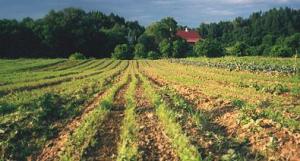
All Vermonters interested in a more resilient agricultural future will not want to miss a remarkable new documentary exploring the history and future of our Mad River Valley’s hill farms. Drawing on historical documents, capturing iconic archival images, and featuring extensive interviews with current Valley farmers, Hill Farming in the Mad River Valley explores how the evolution of land use and agriculture in Vermont has shaped our unique Valley landscape. From the early farmers who cleared the hillsides to today’s 21st century “agripreneurs,” this new film considers the emerging challenges of farming the more fertile floodplain soils, and explores the significance of higher elevation farm land to both our heritage and our continued agricultural vitality as we move into a 21st century shaped by emerging climate change and Peak Oil realities.
Mad River Valley’ites well remember the devastation caused in August 2011 when Hurricane Irene blew through Vermont, dumping more than seven inches of rain on the Green Mountains’ eastern slopes, and turning our downtown neighborhoods, homes, and farms into a collective flood disaster zone literally overnight. As Vermonters have worked hard to clean up the damage, we’ve also moved to apply lessons learned from Irene to a considered accounting of our what our economic future (including farming) might look like in this new millennium. Reminding us that the Mad River has flooded 21 times since 1778, most extensively in 1927, 1998, and 2011, Hill Farming in the Mad River Valley also takes a 200 year look at Valley farming’s evolution, from the Golden Age of Hill Farming (1790s – 1840s) through the arrival and triumph of consolidated commercial dairy farming on the lower Valley floor (complete with the arrival of expensive bulk tanks and concrete flooring) and the marginalization of hill farms in MRV uplands by twentieth century’s end.
What does the future have in store? Hill Farming in the Mad River Valley features the voices of several of our Valley friends and neighbors involved in the ag world, including Ken Blair, Bob Vasseur, Peter Forbes, Elwin Neill, David DeFreest, Duane Howes, Eliza Walker, Martin and Kelly von Trapp, Helen Whybrow, Daniel and Jordan von Trapp, Nacho Villa, Marisa Mauro, Aaron Locker and Joe Klimek. Drawing on their stories and Valley history, the film frames five large lessons for all of us to act on:
Lesson #1: Floods will Happen
And well we know this. Irene’s 2011 devastation of Valley floor-based farming entrepreneurial enterprises like Small Step Farm on Route 100’s Waitsfield/Warren line served as a sober reminder that Nature will take its course, and that farm placement will matter more and more in a new century marked by climatological unpredictability. Extreme weather, in other words, is the “new normal.” Plan for it.
Lesson #2: Soil is Important
All farmers know this in their bones. Soil fertility and health is essential to sustainable food production. How do we build more resiliency into our working landscapes as the 21st century unfolds?
Lesson #3: Choose Crops Carefully and Diversify
All of the film’s farmers have stories to tell. Elwin Neill, for example, on Waitsfield’s North Road, explains how his family made the decision to move from a generations-old dairying operation to a beef cattle farm on the Valley floor – “we took the emotion out of it and looked at it as a business decision,” says Neill. Faysto-based Helen Whybrow and Peter Forbes of Bragg Hill Road’s Knoll Farm, meanwhile, chose to raise high bush blueberries and Icelandic sheep because of their farm’s acidic soil and rocky terrain. “Each farm is so different – it taps into the creativity of the person working it,” Vermont Land Trust director Liza Walker explains. “Look to the land to determine what to do with the space.”
Lesson #4: Protect the Uplands
As we move into this new century, the Valley’s hill farms will become more vital once again. The story of the iconic Bragg Farm property, conserved by a community of citizens led by Fayston town leaders and the Vermont Land Trust, and now farmed by Ploughgate Creamery’s Marisa Mauro (buttermilk and hogs), is a telling example. Rather than letting abandoned hill farms sit idle or be subdivided into private homes, Valley’ites would do well to encourage an agripreneurial return to the uplands – the new normal demands that we adapt our agricultural practices once again, as we have for decades.
Lesson #5: Nurture Creativity and Build Resources
Indeed, the entire film is testament to the entrepreneurial creativity of our friends and neighbors who are making a go of it here in the Mad River Valley. “We feel like we are doing the right thing,” concludes cheesemaker Sebastian von Trapp. “We have support from our community and outlets to sell our cheese.” Other farmers echo his sentiments – it takes a Valley to raise a farm.
Ultimately, Hill Farming in the Mad River Valley is a reasoned and hopeful story of Mad River Valley dwellers’ continued adaptation to changing environmental and economic circumstances, Anyone who cares about our Valley’s future ought to make the time to see it – you will leave inspired AND thinking. Special thanks to Mad River Valley Planning District and the MRV Rural Resource Commission for supporting the film, and to filmmaker Meg Campbell and historian Lyssa Papazian.
Rob Williams is a historian, journalist, musician, media dude, yak herder, and political decentralist. He lives in Mad River Valley, Vermont. Rob is the publisher of 2VR.org
- All
- Agriculture
- Arts & Culture
- Book Reviews
- Civil Liberties
- Decentralism & The Vermont Tradition
- Education
- Empire and Overshoot
- Environment
- Featured Content
- Features
- Film Reviews
- Finance & Money
- Food
- Fuel & Energy
- Global Problems, Local Solutions
- Homestead Security
- Information & Media
- Interviews
- Military
- Most Likely to Secede
- Music Reviews
- Politics
- Resilience & Community
- Sovereignty & Secession
- Uncategorized
- Vermont Commons


You must be logged in to post a comment.